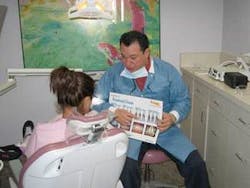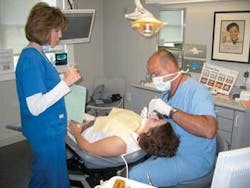Quick Draw McGraw
In dental hygiene, as in all aspects of dentistry, a significant amount of our communication is spent dealing with patient objections or concerns about proposed treatment. These objections can vary from issues with time, money, and insurance assistance to understanding the need for treatment. Being prepared in advance with a fistful of phrases to handle these situations will make shooting from the hip at those objections quite easy!
Memorization, not scripting, is the key to being prepared with good handling phrases. Simply knowing a few short phrases that build value for services and establish continuity with all team members can make a huge difference during difficult or challenging communication. Before we look at some samples of key phrases we should know, let’s take a look at an important principle of good communication - the impact of body language.
Body language, or nonverbal communication, directly influences how others perceive our verbal communication. In fact, studies show about 70 percent of our communication is impacted by body language. This is called proxemics - the way we use our bodies within our physical space. Researcher E.T. Hall coined the term proxemics in 1963 while he was investigating the study of spatial territory for the purpose of communication. There are four categories of proxemics: the intimate distance for embracing or whispering (6 to 18 inches), the personal distance for conversations among friends (1.5 to 4 feet), social distance for conversation among acquaintances (4 to 12 feet), and public distance used for public speaking (12 feet or more).1
Most individuals perceive a distance that is appropriate for different types of communication; indeed they establish a comfortable distance for personal interaction which is defined as their “personal space.” When violation of personal space occurs, it can have serious adverse effects on communication.
You will see that in clinical communication we are primarily using two categories of proxemics - the intimate distance and the personal distance. With that in mind, we must carefully and respectfully approach all chairside communication with our patients.
For the past 26 years, the JP Institute has taught two specific techniques of proxemics, which when applied, will noticeably enhance your communication with patients in the clinical setting, resulting in greater patient understanding as well as increased case acceptance. The first technique is called a mutual loop of influence (eye to eye, knee to knee) body positioning for direct communication between a patient and clinician at the chair. The second technique uses a communication triangle for body positioning when two clinicians are communicating with or about a patient in front of the patient at the treatment chair.
In the first technique, the mutual loop of influence, the patient is always in an upright position - never lying on his/her back - and the clinician is facing the patient. This allows both the patient and the clinician to maintain eye contact and their personal space. Please note that any clinical communication, especially about needed treatment, while the patient is lying on his/her back seriously diminishes the patient’s ability to comprehend what the clinician is attempting to communicate, which then translates into difficulty in making a treatment decision for ideal care (see Figure 1).
This application of proxemics will also enhance the use of any visual aid as long as the clinician holds the visual aid directly in front of him/her. In contrast, holding the visual aid to one side or in front of the patient breaks eye contact and puts the focus on the visual aid itself rather than the patient. Keeping the visual aid directly in front of the clinician allows for brief looks at the aid as well as the immediate reestablishing of eye contact.
In the second technique, the communication triangle, the patient is reclined in the treatment chair while the hygienist and the doctor maintain eye contact with the patient by forming a triangle between the three of them (see figure 2). The hygienist or assistant never steps behind the patient’s head or turns his/her back to the patient during the communication or verbal synopsis. Brief communication (a verbal synopsis) regarding the patient’s clinical status is relayed to the doctor, followed by a clinical exam. Once the verbal synopsis is complete, the clinician relaying the information can step out of the triangle to begin documentation in the patient’s chart or use the computer. After the clinical exam, the doctor raises the patient to an upright position, assuming a mutual loop of influence, and communicates the diagnosis directly to the patient (see Figure 2).
Both of these techniques restore personal space to your patient and, therefore, encourage your patient to talk with you about his/her concerns. With the patient in a supine position, the communication very often remains rhetorical or one-way.
Now that we have the patient in a mutual loop of influence and engaged in a dialogue, the ability to confidently handle patient objections and questions becomes vital. Think of the objection or challenging question coming at you like a ball during a game of two-square. Our instinct is to bounce the ball back into the opponent’s square and score a point. Rather than following our instinct, we should catch the ball. In other words, catch the objection, embrace it, and offer understanding. All too often we respond in a knee-jerk fashion and are perceived by the patient as being defensive. “Catching the objection” gives the clinician an opportunity to take a breath and respond with understanding and compassion.
Patient:“The last time I had my teeth cleaned, nothing was said about my having a gum problem. Why do I have this problem now?”
Hygienist: “I understand how it could be confusing. Let me reassure you that if you were seeing Susan today, she would be just as concerned as I am that your gums are bleeding. Would you like to treat this before it gets worse?”
Here is another example:
Patient:“My tooth isn’t hurting. I’ll just fix it when it breaks.”
Hygienist: “I can understand that fixing the tooth when there is no pain might seem unnecessary, and waiting until it breaks is certainly an option. But it has been my experience that when a patient waits until a tooth breaks, the cost is almost always double, and there is typically pain involved. Wouldn’t you rather go ahead and prevent the pain and inconvenience of a broken tooth by fixing it now?”
In both of the previous examples, the clinician responds by taking a breath, and then uses a softening statement that lets the patient know he/she has not only been heard but also understood. As a clinician you do not have to agree with the patient, but you must relate to him/her, understand him/her, and respond in a nondefensive manner.
The best way to accomplish this is with a softening statement. The softening statement has two parts. The first is understanding, acknowledging, and agreement, if applicable. The second is restating the patient’s question or objection. Once you have made your softening statement, follow it up with a solution to the problem or an answer to the question. And then, most importantly, ask a question of your own.
Ending your response by asking the patient a question puts you back in control of the dialogue, gives closure to your comments, and keeps you from going on and on handling the objection. When we continue to justify our position or treatment recommendations, it appears to the patient that we are trying to talk them into the treatment. It’s better to keep it simple, handle the question, and then ask one of your own, thus moving the dialogue forward.
Typically the next question will be: “How much will it cost?” This is where memorization will pay off. Using the “fee sandwich” technique for quoting a fee will forever make your life easier when it comes to talking about money. The concept simply involves stating value for the procedure, followed by the fee, and topped off with more value.
Patient: “How much will it cost to fix my cracked tooth?”
Hygienist: “In order to restore your tooth to its natural form and function, the fee will range from $350 to $1,100, depending upon how deep the crack goes and the amount of healthy tooth left behind. I do know that Dr. Smith will do the most conservative treatment possible. Do you have any other questions?”
In this example, the clinician quotes a fee range from the most expensive composite restoration to a full-coverage crown. Since the hygienist does not diagnose the exact restoration, this is a very reasonable way to let the patient know the cost no matter what type of restoration the doctor diagnoses. If the tooth has already been diagnosed, simply omit the range and quote the exact fee for the recommended treatment.
To quote a fee for any type of treatment provided in your practice, make a set of index cards with the name of the treatment at the top, followed by a list of value statements applicable to that treatment. This project could easily be divided among all team members. Once your index cards are ready, simply memorize the value statements attached to each type of treatment. From that point forward, quoting a fee for any type of service will flow very naturally using the fee sandwich technique.
This technique will work equally well on the telephone. The most common fee question over the phone is, “How much is a cleaning?” Rather than responding by just stating the fee, why not attach some value and set your office apart from other dental offices in your neighborhood? For example:
Caller: “How much do you charge for a cleaning?”
Responder: “In Dr. Smith’s office, our cleaning includes a blood pressure and health history screening, an oral cancer screening, followed by a tooth polishing and professional cleaning. The fee is $75 and our registered dental hygienist will spend about an hour with you. Would you like to make an appointment?”
Can you see how responding with this technique will create value for any procedure you quote over the telephone? Many consultants say never to quote fees over the phone. I disagree. If the “fee sandwich” technique is mastered, quoting the fee over the phone is no longer a problem. No matter what the procedure, you are creating value in abundance for the caller … and at the very least, you have set your practice apart. There is certainly no harm in that.
While we are on the subject of quoting fees, I’d like to take a quick detour. Many doctors have been told sometime in their career that they should never be the one to quote the fee. Looking at this from the consumer’s perspective, does that make sense? Does the butcher know the price for the beef? Does the real estate agent know the cost of the home he/she is showing you? Does the plumber give you an idea of cost for his/her services? Of course, or you could not make a decision to purchase the product or service. An exact quote is never necessary, but at a minimum a fee range should always be given. When giving a fee range, always round up so the actual cost of treatment is less than the verbal quote rather than more.
Insurance questions rank very high on the list too. Even if you are in a fee-for-service practice, you still have to deal with insurance issues and questions. Although many patients don’t rely on insurance to fund their dental treatment, they will still want their questions answered regarding how their benefits can be used to assist in their treatment needs.
Patient: “Will my insurance cover it?”
Hygienist:“That’s a great question and one almost everybody asks. Your insurance company will give you some assistance with the cost of treatment. As you know, Dr. Smith would never let the insurance dictate what he recommends as the best treatment for your situation. Let’s assume we (or Jill at the front desk) can help you find a way to fit this treatment into your monthly budget. Do you want to repair the cracked tooth?”
Let’s look at another option for this common objection…
Patient: “Will my insurance pay for the treatment?”
Hygienist: “I can understand that fixing the tooth when there is no pain might seem unnecessary, and waiting until it breaks is certainly an option. But it has been my experience that when a patient waits until a tooth breaks, the cost is almost always double, and there is typically pain involved. Wouldn’t you rather go ahead and prevent the pain and inconvenience of a broken tooth by fixing it now?”
Hygienist: “Thank you for asking. Maximizing your insurance benefit is certainly something we will help you with. I’m sure you know Dr. Smith would never minimize your treatment recommendations because of insurance limitations. We have several options to assist you in fitting the treatment into your budget. Do you have any other questions?”
Remember to handle these questions and objections to treatment using the two techniques of proxemics discussed here. You will find that you greatly increase the effectiveness of your communication, which will result in an increase in case acceptance and healthier patients.
Combining proxemics with the use of softening statements, followed by an answer and a question of your own, is the template for handling all objections and questions. Practice these techniques in planned role-playing sessions with your team members. At first it will seem awkward and your responses may not flow smoothly. Once you have practiced the proxemics techniques as well as memorized the value statements, you will see that your patients will be more compliant and eager to follow through with the treatment suggestions you have made. Soon you will find yourself easily “shooting from the hip” at objections. RDH
References
1 Body Language, The Significance of Body Proxemics.



